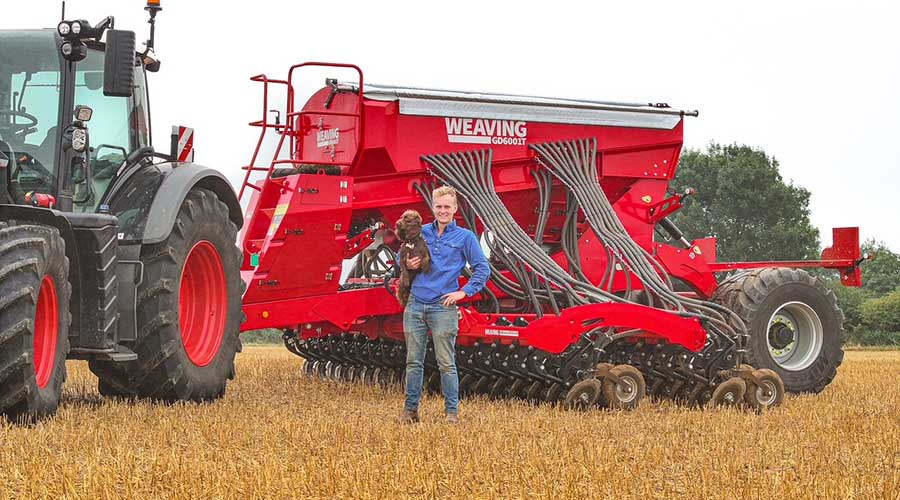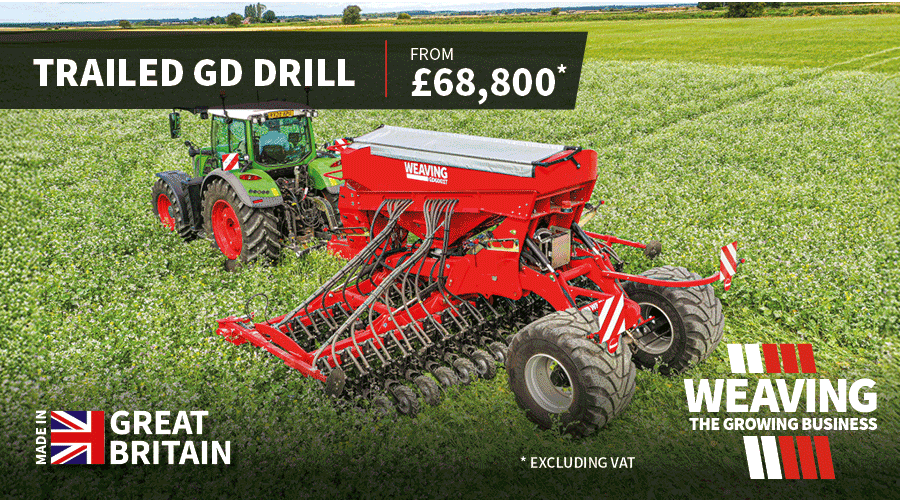Weaving GD drill gives young farmer’s no-till enterprise a boost
27th January 2025
Farmer and contractor, Tom Matthews purchased a Weaving trailed GD drill funded in part by a FETF grant in 2023, and has been impressed by both its value and performance.

At the age of 26, Tom Matthews already runs his own family farm, contracting business and share farming agreement in Marston Magna, Somerset.
His family enterprise, Little Marston Farm, comprises 105ha which, after taking back in-hand, allows Tom to farm independently. Two thirds of the hectarage are down to wheat, with the remainder used for beans or oilseed rape as break crops.
Little Marston has been farmed in a no-till system for a number of years, and Tom wanted to continue the efforts of the previous contractor to maintain the no-till system.
As part of a share farming agreement on the 300ha holding with neighbours, Hugh and Tim Archer, the trio plant winter milling wheat, spring malting barley, beans and oilseed rape. Not stopping there, Tom has, in more recent times, also developed his own contracting business, drilling 440ha annually operating as Marston Agriculture.
Machinery investments
Having initially got underway with a hired tine drill, Tom looked to add a disc drill to his toolbox, opting for Weaving Machinery’s trailed GD drill.
With soil varying from heavy clay to Cotswold Brash through to sand, Tom wanted to invest in a drill which suited both farms. He explains he struggled with the tine drill, particularly in controlling the depth and disturbing too much soil.
He explains: “I still have access to a tine drill which I use when conditions dictate. I bought the GD because I wanted a disc drill to achieve lower disturbance and better ground following via the individual coulter movement.”
Tom continues: “When I was looking at drills on the market, price was a big driver and I found Weaving’s GD to be substantially better value. I dealt with sales director Simon Weaving himself, which is something I also really appreciated. It’s assuring that you can speak to Weaving directly, rather than going through a long chain of people.
“If I need parts, and if I really need to, I can drive to the factory and pick something up in a manageable time. If something is going to go wrong, it’s usually at about 5pm on a Friday. If I give Mike Lane from Weaving a call and he can’t solve the problem over the phone, he will be in the yard at 7:30am the next morning with a van-full of parts and will get me going again very quickly.
“I can’t thank him enough for his excellent service and always picking up the phone. A few neighbours also have Weaving drills and our Agrii agronomist, Todd Jex, encourages their use so there are plenty of people on hand for advice, tips and tricks.”

Healthy soil and net margins
Striving for a full no-till system, Tom says he acknowledges the soil health benefits this brings but is more focused on the improvements to his net margin it can provide.
Tom bought the drill on a Farming Equipment Technology Grant (FETF) grant last year, receiving a £25,000 grant towards the cost.
On making the purchase, Tom chose to have a split tank, containing three hoppers which Tom describes as “opening up a whole range of new options.” It is a huge time saver as you can carry a number of different crops so there is no need to stop, clean the tank out and calibrate when you are doing multiple crops for a customer.
Tom says: “You can run multiple variable rate prescriptions through the split tank and can simultaneously fertilise, drill and place slug pellets if necessary.”
He continues: “With a GD, the aim is to avoid cultivating as much as possible. The cost of the drill is countered by the cheaper establishment costs if the crop comes well. No-till doesn’t seem to disturb the weed bank, which should help to cut down on chemical spend.
“I carry out 400ha of stubble-to-stubble drilling and spraying myself. Working in this way with the GD, it allows me to cover the ground in a manageable time.
No-till also ties in with Tom’s efforts to tackle black-grass. Through no-till and a diverse rotation, he has been able to make improvements in this respect on Hugh and Tim’s farm.
Tom comments: “Previously, the farm heavily depended on spring barley. By increasing the area of winter cropping and therefore varying the sprays used, there has been more of an impact on black-grass control.”
In a wet year on the light ground, the crops came well with the GD, says Tom, explaining the winter wheat drilled on light ground was particularly good.
Impressive products and service
So impressed with the products and the service from Weaving, Tom has since purchased a Shortdisc and Stubble Rake to add to his collection.
The Shortdisc was purchased on Weaving’s three-year 0% finance deal and was purchased to work predominantly on the home farm which frequently floods and has a lot of rotten tramlines. He says the ground needed levelling, subsoiling and short discing. Again opting for the 6m, Tom says once you get to a size where the implement folds, they don’t get that much more expensive.
The Stubble Rake is kept for a fully no-till situation and is to run over ground to spread trash to control slugs and encourage a weed chit. It has been especially useful to level off ridges left by the subsoiler, leaving the field ready to drill, he says.
Tom concludes: “I have been very happy with my experience in dealing with Weaving and their backup support. I would recommend anyone to at least have a chat and get a quote. They’re in the game for the long run.”
Visit the Weaving Machinery website for more information.
Read more machinery news
